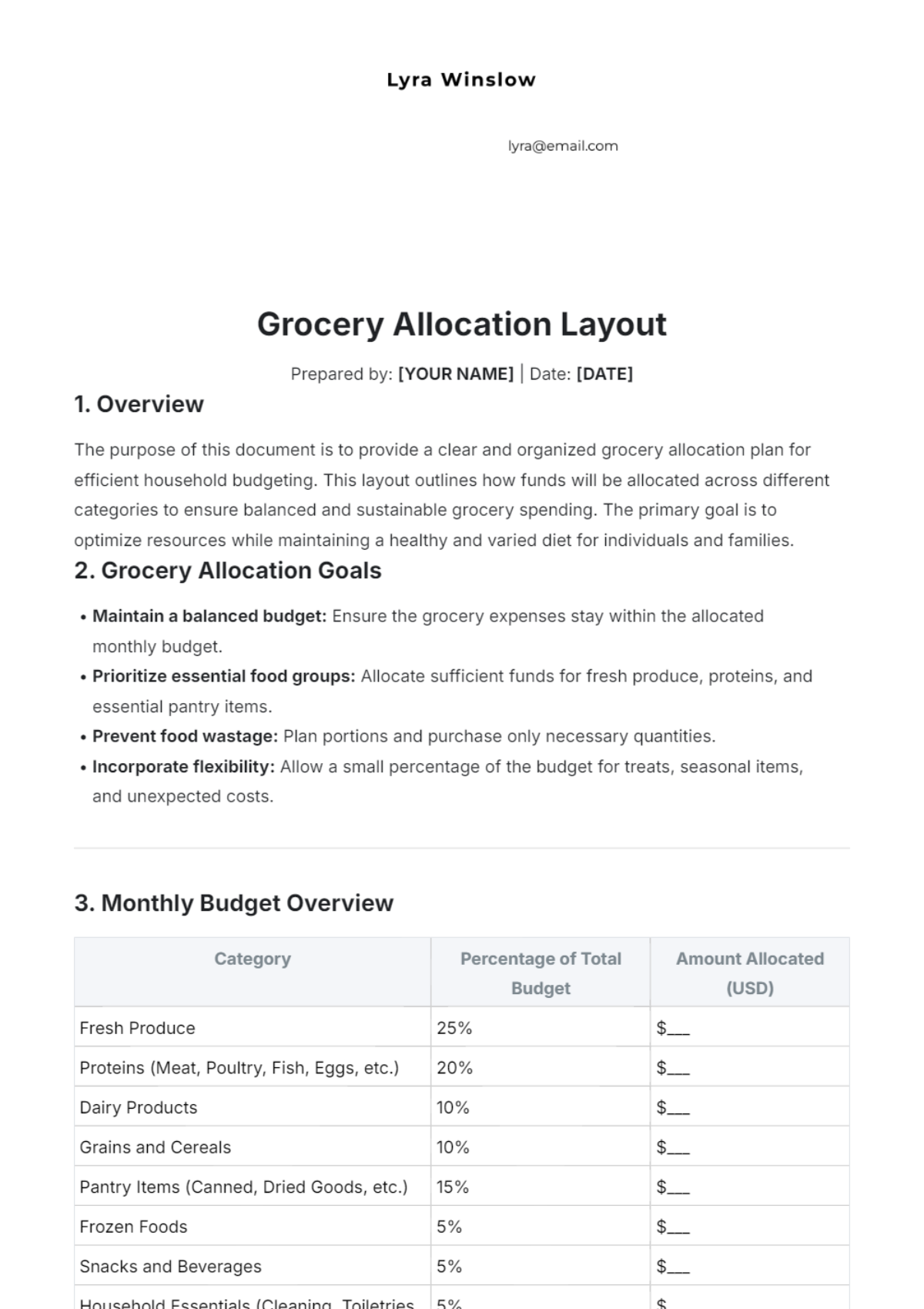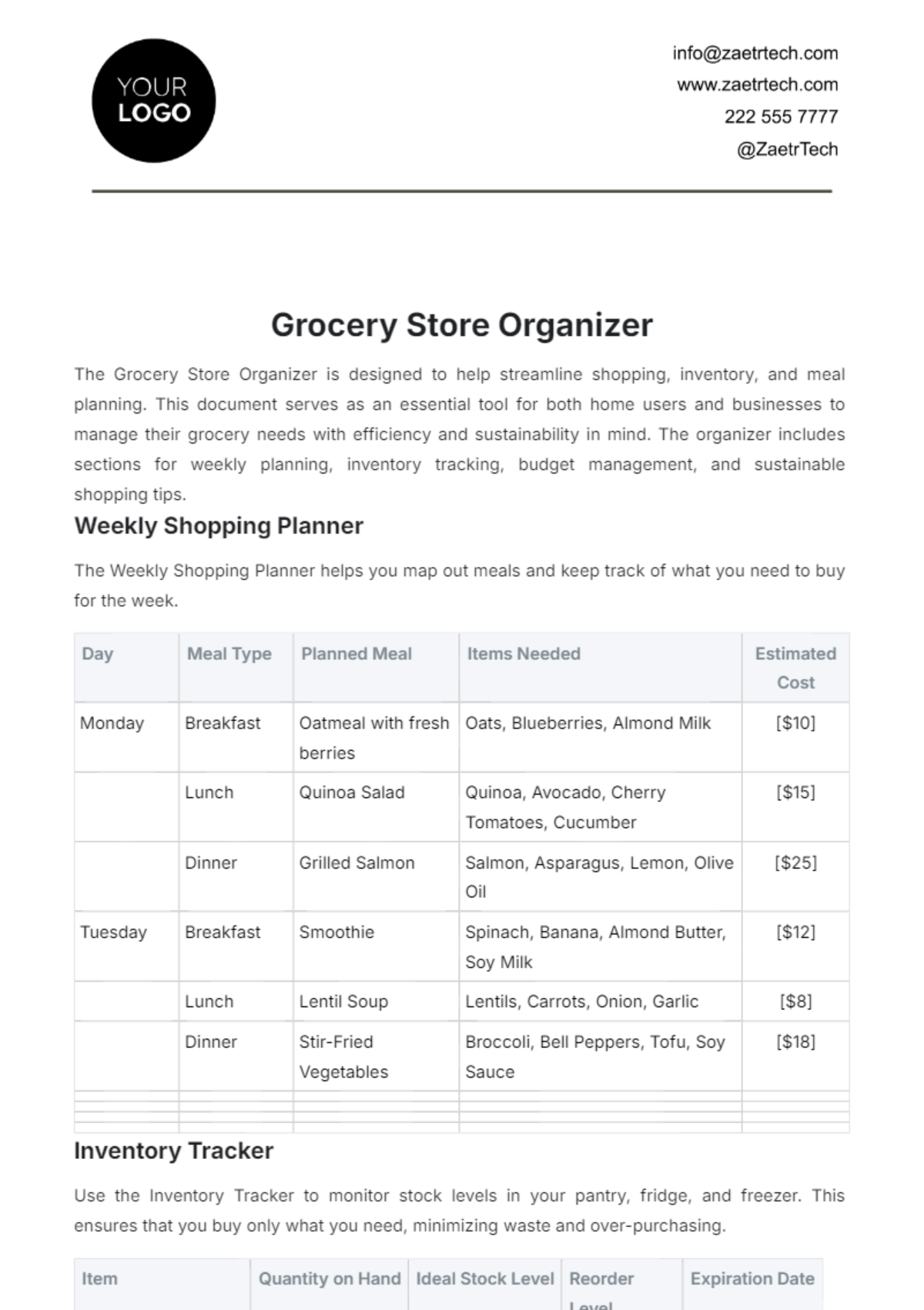Blank Grocery Store Customer Service SOP
I. Introduction
A. Purpose
(The purpose of this SOP is to establish consistent guidelines for customer service representatives at [Your Company Name]. Describe the importance of customer service in creating a positive shopping experience and ensuring customer satisfaction.)
B. Scope
(This section defines the scope of the SOP, detailing who it applies to within the organization. Mention that it applies to all customer service representatives and related personnel.)
C. Definitions
(Provide definitions for key terms used throughout the SOP. This can include definitions for "customer service representative," "customer," "complaint," "inquiry," etc.)
II. Customer Service Standards
A. Customer Interaction Guidelines
(Outline the general principles for interacting with customers. Include instructions on maintaining professionalism, being courteous, listening actively, and responding promptly.)
Professionalism
(Explain the importance of professionalism in customer interactions. Provide guidelines on maintaining a professional demeanor, language, and appearance.)
Courtesy
(Detail the importance of being courteous. Include instructions on greeting customers, using polite language, and showing respect.)
Active Listening
(Describe the principles of active listening. Provide guidelines on how to demonstrate understanding, avoid interrupting, and clarify customer needs.)
Prompt Response
(Explain the importance of responding promptly to customer inquiries and issues. Include timeframes for response and follow-up.)
B. Handling Customer Inquiries
(Provide detailed steps for handling different types of customer inquiries. Include procedures for answering questions about products, store policies, and services.)
Product Information
(Detail how to provide accurate and helpful information about products. Include instructions on using store resources and knowledge to assist customers.)
Store Policies
(Explain how to communicate store policies clearly and accurately. Include guidelines for addressing common policy-related questions.)
Services Offered
(Describe how to inform customers about the services offered by the store. Include details on special services, such as delivery or online ordering.)
C. Managing Customer Complaints
(Outline the procedures for effectively managing customer complaints. Include steps for acknowledging the complaint, investigating the issue, and providing a resolution.)
Acknowledging the Complaint
(Provide instructions on how to acknowledge and show empathy for the customer's complaint. Emphasize the importance of listening and understanding the customer's perspective.)
Investigating the Issue
(Detail the steps for investigating the complaint. Include procedures for gathering information, consulting with relevant departments, and documenting findings.)
Providing a Resolution
(Explain how to offer a resolution to the customer. Include guidelines for proposing solutions, following up, and ensuring customer satisfaction.)
D. Handling Difficult Customers
(Describe strategies for handling difficult or upset customers. Include techniques for de-escalating situations, maintaining composure, and seeking assistance if needed.)
III. Communication Skills
A. Verbal Communication
(Provide guidelines on effective verbal communication with customers. Include tips for speaking clearly, using positive language, and adjusting tone based on the situation.)
Clarity
(Explain the importance of speaking clearly. Provide instructions on avoiding jargon, speaking at an appropriate pace, and ensuring the customer understands.)
Positive Language
(Describe how to use positive language to create a constructive interaction. Include examples of positive phrases and avoiding negative language.)
Tone
(Detail the significance of adjusting tone based on the situation. Provide guidelines on using a friendly, respectful, and empathetic tone.)
B. Non-Verbal Communication
(Outline the principles of effective non-verbal communication. Include tips for maintaining appropriate body language, eye contact, and facial expressions.)
Body Language
(Explain how body language can impact customer interactions. Provide guidelines on maintaining an open and approachable posture.)
Eye Contact
(Describe the importance of making appropriate eye contact. Include instructions on how to balance eye contact to show attentiveness without making the customer uncomfortable.)
Facial Expressions
(Detail how facial expressions can convey emotions and attitudes. Provide guidelines on maintaining a friendly and engaged expression.)
IV. Transaction Procedures
A. Point of Sale (POS) System
(Describe the procedures for using the POS system. Include steps for processing sales, returns, and exchanges.)
Processing Sales
(Provide detailed instructions on processing sales transactions. Include steps for scanning items, applying discounts, and finalizing the sale.)
Handling Returns
(Explain the procedures for processing returns. Include steps for verifying the return, issuing refunds, and updating inventory.)
Managing Exchanges
(Detail the process for handling exchanges. Include instructions on verifying the exchange, updating inventory, and ensuring customer satisfaction.)
B. Payment Methods
(Outline the procedures for accepting various payment methods. Include instructions for handling cash, credit/debit cards, and other payment options.)
Cash Transactions
(Provide guidelines on handling cash transactions. Include steps for receiving cash, making change, and ensuring accuracy.)
Credit/Debit Card Payments
(Explain the procedures for processing credit and debit card payments. Include steps for swiping/inserting cards, verifying information, and obtaining signatures if required.)
Alternative Payment Methods
(Describe how to handle alternative payment methods, such as mobile payments or store credit. Include instructions for processing these transactions and verifying payment.)
V. Inventory Management
A. Stock Replenishment
(Detail the procedures for monitoring and replenishing stock levels. Include steps for checking inventory, ordering new stock, and restocking shelves.)
Checking Inventory Levels
(Provide instructions on how to regularly check inventory levels. Include details on using inventory management systems and physical counts.)
Ordering New Stock
(Explain the process for ordering new stock. Include steps for placing orders, communicating with suppliers, and tracking deliveries.)
Restocking Shelves
(Detail the procedures for restocking shelves. Include instructions on how to rotate stock, ensure product availability, and maintain a tidy display.)
B. Handling Damaged Goods
(Outline the procedures for handling damaged or expired goods. Include steps for identifying, removing, and documenting these items.)
Identifying Damaged Goods
(Provide guidelines on how to identify damaged or expired goods. Include instructions on what to look for and how to handle these items.)
Removing Damaged Goods
(Explain the process for removing damaged goods from shelves. Include steps for safely disposing of these items or returning them to suppliers.)
Documenting Damaged Goods
(Detail the procedures for documenting damaged goods. Include instructions on recording details in inventory systems and reporting to management.)
VI. Safety and Security
A. Store Security
(Describe the procedures for maintaining store security. Include steps for preventing theft, handling suspicious activity, and ensuring a safe environment for customers and staff.)
Preventing Theft
(Provide guidelines on how to prevent theft. Include instructions on monitoring for suspicious behavior, using security systems, and following store policies.)
Handling Suspicious Activity
(Explain how to handle suspicious activity. Include steps for identifying, reporting, and addressing such activity.)
Ensuring a Safe Environment
(Detail the procedures for ensuring a safe environment. Include guidelines on maintaining clear aisles, properly storing products, and addressing hazards.)
B. Emergency Procedures
(Outline the procedures for handling emergencies. Include steps for responding to medical emergencies, fires, and other critical situations.)
Responding to Medical Emergencies
(Provide instructions on how to respond to medical emergencies. Include steps for assisting the customer, contacting emergency services, and documenting the incident.)
Fire Safety
(Explain the procedures for fire safety. Include steps for evacuating the store, using fire extinguishers, and contacting emergency services.)
Other Critical Situations
(Detail how to handle other critical situations, such as natural disasters or power outages. Include guidelines for ensuring customer and staff safety.)
VII. Training and Development
A. Initial Training
(Describe the initial training program for new customer service representatives. Include topics covered, duration, and evaluation methods.)
Training Topics
(Provide a list of topics covered in initial training. Include customer service principles, store policies, product knowledge, and POS system usage.)
Training Duration
(Explain the duration of the initial training program. Include a timeline for each training module and overall training period.)
Evaluation Methods
(Detail the methods used to evaluate trainees. Include assessments, practical exercises, and feedback sessions.)
B. Ongoing Training
(Outline the procedures for ongoing training and development. Include steps for providing regular training sessions, addressing knowledge gaps, and keeping staff updated on changes.)
Regular Training Sessions
(Provide guidelines on scheduling and conducting regular training sessions. Include frequency, topics covered, and methods of delivery.)
Addressing Knowledge Gaps
(Explain how to identify and address knowledge gaps. Include steps for assessing performance, providing additional training, and offering support.)
Keeping Staff Updated
(Detail the procedures for keeping staff updated on changes. Include instructions on communicating policy updates, new products, and procedural changes.)
VIII. Performance Evaluation
A. Evaluation Criteria
(Describe the criteria used to evaluate customer service representatives' performance. Include key performance indicators (KPIs) such as customer satisfaction, response times, and adherence to procedures.)
Customer Satisfaction
(Provide guidelines on measuring customer satisfaction. Include methods such as surveys, feedback forms, and direct customer feedback.)
Response Times
(Explain how to evaluate response times. Include criteria for acceptable response times and methods for tracking performance.)
Adherence to Procedures
(Detail the criteria for assessing adherence to procedures. Include guidelines on observing interactions, reviewing documentation, and providing feedback.)
B. Feedback and Improvement
(Outline the procedures for providing feedback and encouraging improvement. Include steps for conducting performance reviews, offering constructive feedback, and setting goals for development.)
Conducting Performance Reviews
(Provide instructions on how to conduct performance reviews. Include frequency, format, and key discussion points.)
Offering Constructive Feedback
(Explain how to offer constructive feedback. Include guidelines on being specific, focusing on behaviors, and offering solutions.)
Setting Goals for Development
(Detail the process for setting development goals. Include steps for identifying areas for improvement, creating action plans, and monitoring progress.)
IX. Documentation and Record Keeping
A. Customer Service Logs
(Describe the procedures for maintaining customer service logs. Include instructions on what information to record, how to store logs, and how to use them for performance improvement.)
Information to Record
(Provide guidelines on what information should be recorded in customer service logs. Include details on customer interactions, inquiries, complaints, and resolutions.)
Storing Logs
(Explain the procedures for storing customer service logs. Include guidelines on using digital systems, ensuring data security, and maintaining accessibility.)
Using Logs for Improvement
(Detail how to use customer service logs for performance improvement. Include instructions on analyzing logs, identifying trends, and implementing changes.)
B. Incident Reports
(Outline the procedures for documenting incidents. Include steps for creating incident reports, what information to include, and how to submit reports.)
Creating Incident Reports
(Provide instructions on how to create incident reports. Include steps for documenting details, using the correct format, and ensuring accuracy.)
Information to Include
(Explain what information should be included in incident reports. Include details on the incident, individuals involved, and actions taken.)
Submitting Reports
(Detail the procedures for submitting incident reports. Include guidelines on who to submit reports to, timelines for submission, and follow-up actions.)
X. Review and Revision
A. Regular Review
(Describe the procedures for regularly reviewing the SOP. Include steps for scheduling reviews, involving relevant stakeholders, and documenting changes.)
Scheduling Reviews
(Provide guidelines on how often the SOP should be reviewed. Include a recommended frequency and key times for review, such as after major changes.)
Involving Stakeholders
(Explain who should be involved in the review process. Include instructions on involving management, customer service representatives, and other relevant personnel.)
Documenting Changes
(Detail the procedures for documenting changes to the SOP. Include steps for recording revisions, updating the document, and communicating changes.)
B. Making Revisions
(Outline the procedures for making revisions to the SOP. Include steps for proposing changes, reviewing suggestions, and implementing updates.)
Proposing Changes
(Provide instructions on how to propose changes to the SOP. Include guidelines on submitting suggestions, providing rationale, and considering feedback.)
Reviewing Suggestions
(Explain the process for reviewing suggestions. Include steps for evaluating proposals, consulting with stakeholders, and making decisions.)
Implementing Updates
(Detail the procedures for implementing updates to the SOP. Include steps for revising the document, communicating changes, and providing training on new procedures.)
























